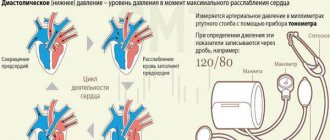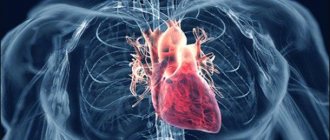What is low blood pressure?
In the medical literature, the standard pressure indicator for a person from twenty to forty years old is considered to be 12080. A slight decrease is not considered a deviation from the norm. Since most people have an “upper” working pressure in the range from 110 to 130, and a lower one from 70 to 90, with such figures they feel excellent and do not complain about their health. The consequences do not appear. Hypotension begins when the patient, with numbers below 12080, experiences a deterioration in well-being, which manifests itself in:
- impaired coordination of movements;
- confusion;
- the presence of dark spots before the eyes;
- general weakness;
- tinnitus;
- states close to fainting;
- fainting;
- sweating;
- feeling of nausea;
- lack of air;
- pallor or blue discoloration of the skin;
- dizziness.
These symptoms are signs of several diseases, but if a person experiences more than three of them, there is a high probability that he has low blood pressure, which has certain consequences.
It is dangerous when, with low blood pressure, the patient’s heart rate is more than 90 beats per minute. In such cases, urgent medical attention is required; the consequences of failure to provide emergency assistance are serious.
The table below shows the deviation limits for a healthy middle-aged patient leading a normal lifestyle.
Depending on the etiological factors and the totality of manifestations of signs of the disease, several types of hypotension are distinguished:
- Orthostatic, with a sudden change in the position of the body. For example, quickly getting out of bed or from the sofa in the morning, a person feels tinnitus, darkness before his eyes, and dizziness. The consequences are fainting and impaired spatial coordination. The reason is improper blood circulation and weakened heart activity. It appears in women carrying a child, in patients with diabetes, in patients with a central nervous system disorder.
- Postprandial, when the cause of low blood pressure is the next meal. The consequences are smoothed out by eating fractionally and avoiding sugar;
- VSD, observed in adolescents, children and women under twenty-five years of age. Systematic low blood pressure is sometimes observed against the background of impaired functions of the part of the nervous system that controls the activity of internal organs, glands and blood vessels.
Often all types of hypotension are present in the same patient.
As long as a person does not experience pathological symptoms during periods of low blood pressure, it is believed that the blood sufficiently supplies oxygen to the tissues and organs, the consequences and causes of low blood pressure are not serious.
For athletes, the working pressure is sometimes considered to be 9060. People with increased constant physical activity may also not notice a deterioration in their health. An ordinary person over 30 years old with such low levels is capable of losing consciousness.
Individual figures for normal pressure depend on the patient’s age and gender. From fifteen to nineteen years, one of the root causes of low blood pressure is hormonal changes and a time of intensive maturation.
Both systolic (“upper,” indicating the force of blood ejection into the aorta and the speed of its flow to the organs) and diastolic (“lower,” indicating the pressure in the vessels, which is measured between heartbeats) pressure can be reduced. Experts believe that if the internal organs are healthy and there are no other diseases, then the causes of low heart pressure and its consequences should not worry.
After some time, the symptoms will go away.
How to keep blood pressure and hemoglobin normal?
To keep your hemoglobin levels normal, you need to eat foods rich in iron. Hemotogen is very useful; you should eat this supplement one slab a day. Eat more vegetables, which help the body absorb iron.
Some tips:
- Avoid coffee and tea.
- Improve your diet by including more apples, carrots and pomegranates in your diet.
- Take daily walks.
- Spend weekends in nature.
Hemoglobin is a very important element in the blood; its decrease affects not only blood pressure, but also the condition of the body as a whole. Anemia is often caused by other ailments, which are also important to identify in time. Therefore, before starting treatment, it is important to undergo an examination and exclude other, unpleasant diagnoses that provoke the disease.
Causes of persistently low blood pressure
In medicine, there are two types of hypotension:
- physiological (primary causes);
- pathological (secondary causes).
They differ in the etiology of manifestation, symptoms and consequences.
Physiological reasons
Physiological reasons are due to a hereditary predisposition to low blood pressure levels that do not exceed normal limits. This hypotension manifests itself as:
- individual norm - often depends on the person’s physique;
- high-training hypotension - the vessels supplying blood to the muscles dilate, causing a decrease in pressure; there is no need to increase it;
- adaptive hypotension - occurs in residents of mountains, tropical and subtropical regions, and the Far North.
This explains why the causes of low blood pressure do not indicate the presence of a serious pathology in the body, the symptoms appear unnoticed, and urgent treatment is not required.
Hypotension often occurs in a chronic form and has fatal consequences. Therefore, the causes of low blood pressure often remain unidentified. People do not pay due attention to their health and do not see a doctor.
During periods of low blood pressure, a person does not feel severe ailments and other alarming symptoms. He continues to be able to work and leads a normal life, adapting to the barely noticeable manifestations of the disease.
Primary low blood pressure will not bother you if simple conditions are met. It is enough to adhere to a healthy lifestyle and streamline your daily routine in order to prevent unwanted consequences and not think about the causes.
The doctor will help determine the causes of low systolic and diastolic pressure, assess the consequences, and prescribe sedatives. Self-medication for low blood pressure is prohibited.
A good therapeutic effect in the treatment of physiological hypotension is provided by gymnastics and swimming in the pool, hydro- and manual massage, and reflexology sessions.
Pathological causes
Pathological hypotension is characterized by:
- sudden weakening of vascular tone (collapse);
- reduced supply of oxygen to the brain of the head (hypoxia);
- paralytic vasodilation (shock).
Why does periodic hypotension occur?
Until recently, it was believed that periodic hypotension was the lot of older people. But in recent decades, cases of periodic low blood pressure in children, adolescents and young adults have become more frequent.
The acute form of hypotension is dangerous for the development of stroke. If your health suddenly deteriorates, you must urgently call an emergency ambulance team. In this case, the severity of the disease is determined not by blood pressure data, but by the rate of pressure drop.
In young age
Constantly repeating low numbers on a tonometer when measuring blood pressure in children indicate hypotension.
If the child does not experience constant heavy loads (when playing sports, for example) or this is not one of the ways the body adapts to environmental changes, then the pathology can be caused by the following reasons:
- heredity (usually on the maternal side);
- disturbances in the activity of the endocrine system;
- heart and vascular diseases.
In adolescence, the degree of psycho-emotional stress plays an important role when:
- a child’s illnesses are the consequences of losing a loved one or being raised in a single-parent family;
- he is brought up in unfavorable social conditions;
- experiences mental fatigue;
- there is a history of physical inactivity.
In adolescents, lag or advance in physical development is one of the root causes of low blood pressure. With age, all indicators normalize, and the consequences of low blood pressure cease to worry. At this time, it is important to provide him with the correct daily routine and nutrition, protect him from stress and provide reasonable physical activity.
Over time, neglected hypotension can become chronic and cause irreversible consequences. Any complaints from children about illness require consultation with a doctor.
Low blood pressure is less common in young men than in women.
The reasons are:
- damage to the body by acute and chronic infections;
- allergy;
- physical and mental stress;
- hereditary disorder of blood vessel tone;
- work in hazardous production;
- alcohol abuse;
- other factors mentioned above.
In women in the reproductive period of life, low blood pressure often occurs during pregnancy and appears at the end of the second - beginning of the third trimester.
The risk comes from the fact that hypotension is asymptomatic. Daily monitoring of blood pressure readings is of great importance for a pregnant woman.
Common causes of low blood pressure in pregnant women:
- consequences of a malfunction of the hormonal system;
- the formation of a channel in the uterus and placenta that retains blood;
- weakening of vascular resistance to blood flow;
- inhibition reactions prevail over irritation reactions.
Women often do not pay attention to signs of low blood pressure because they consider them normal for their situation. But we must remember that the causes and consequences of low maternal blood pressure pose a threat to the normal formation and growth of the fetus.
In the elderly
Elderly people suffer from low blood pressure for various reasons. In addition to the congenital factor, hypotension can be provoked by:
- heart failure;
- taking medications;
- poisoning;
- weather dependence;
- bleeding;
- infections;
- physical and emotional overload.
A common cause of periodic hypotension in older people is a major heart attack. The consequences are such that necrotic-fibrous processes occurring in the heart muscle reduce the force of its contractions. Therefore, patients who previously suffered from hypertension may become hypotensive.
With low blood pressure, experts recommend that older people do light morning exercises and breathing exercises. Regular exercise will help improve your well-being, get rid of anxiety symptoms and prevent unpleasant consequences.
How to increase hemoglobin?
The most reliable and simplest way to increase hemoglobin in hypotensive patients is to prescribe medications containing iron. But first consultation with doctors is required to take into account other ailments that may provoke the disease.
Recommended drugs:
- Ferlatum. The active substance is succinylate.
- Maltofer . Available in the form of chewable tablets, drops, syrups. The base is iron hydroxide polymaltosate.
- Heferol. Sold in the form of capsules made from iron fumarate.
It is prohibited to take these drugs with tetracycline antibiotics, antacids and calcium supplements. Their composition affects iron absorption.
How to increase low hemoglobin in pregnant women?
Since low hemoglobin is a common occurrence in pregnant women, it cannot be ignored, since oxygen starvation is harmful for both mother and baby. An alarming symptom is indicators of 100 g/l. If the numbers show up to 70 g/l, this is already considered a severe form and requires a blood transfusion.
Treatment:
- Preparations containing iron.
- Dishes of meat, fish, eggs, herbs, fruits and nuts.
Anemia is less tolerated by men, but has more serious consequences in women.
How to increase blood pressure with low hemoglobin?
Special medications help raise hemoglobin levels and blood pressure readings. But only a doctor should prescribe them.
List:
- Fenyuls.
- Sorbifer durules.
- Folamin.
- Ferretab composite.
The following products will help correct the situation:
- cereals;
- liver;
- red fish;
- prunes;
- pomegranate;
- red berries and vegetables;
- nuts;
- bananas;
- grape;
- watermelons;
- melons;
- apples.
This article will tell you more about fruits that increase blood pressure.
This is what traditional medicine offers for low blood pressure.
- Pour kefir over raw buckwheat overnight. Eat on an empty stomach.
- Drink several glasses of rose hip decoction a day.
- Use a mixture of sprouted wheat and honey.
Consequences
Long-term low blood pressure in patients of any age causes many complications:
- insufficient blood circulation in the brain, oxygen starvation impairs memory and reduces concentration, a person begins to experience constant weakness and gets tired quickly;
- over time, hypotension can degenerate into hypertension - such degeneration is difficult to treat, and the increase in pressure is more difficult for former hypotension patients than everyone else;
- the likelihood of a heart attack, stroke, and the development of kidney failure increases;
- during pregnancy, hypotension leads to oxygen starvation of the fetus, impairing its growth and development;
- in schoolchildren, hypotension leads to a decrease in physical and mental activity;
- the acute form of hypotension causes hypoxia and bleeding of tissues and organs;
- possible fainting increases the likelihood of injury from a fall;
- Frequent attacks of hypotension can cause a person to develop dementia or stroke.











